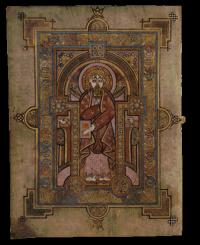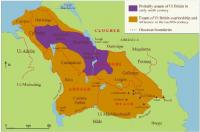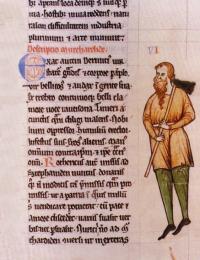‘A man of great power for a long time’:Tigernán Ua Ruairc and the Book of Kells
Published in Features, Issue 5 (Sept/Oct 2010), Pre-Norman History, Volume 18
An illuminated page from the Book of Kells. The notitiae that record Tigernán’s munificence no longer survive in the original manuscript in Trinity College, Dublin. (Trinity College, Dublin)
Depending on the source and time, Tigernán Ua Ruairc (ob. 1172), the great twelfth-century king of Bréifne, was variously described as a ‘man of great power for a long time’, the ‘surpasser of the Irish in power and in abundance’ and a ‘one-eyed villain, meditating treachery’. In his youth he was anathematised as the perpetrator of deeds that were ‘of evil consequence, that merited the curse of the men of Ireland, both laity and clergy’, yet years later, according to the same source, his murdered corpse was ‘a sight of intense pity to the Irish’. But on what evidence can we assess these conflicting accounts?
The careers of many medieval Irish kings can be partially reconstructed and analysed using the extant (and often terse) medieval Irish annals, but even so we are often at a loss to explain the motivations for many of their actions. Fortunately, in the case of Tigernán we have more than just the annals to draw on, including a number of rare administrative documents, which were originally recorded in the most famous Irish manuscript of all, the Book of Kells. One of these often overlooked documents, in which Tigernán’s generosity towards the church of Int Ednén (‘The Ivied One’, modern Inan in south-west Meath) is recorded, offers interesting insights into the political strategies of one of the most brilliant and mercurial figures of twelfth-century Ireland.
The documents in the Book of Kells
The Book of Kells, in addition to its breath-taking decoration and Gospel texts, contains a number of notitiae (short records of land transactions), which were written in its blank spaces and margins during the eleventh and twelfth centuries. The recording of transactions in Gospel-books, which were often associated with venerated saints (the Book of Kells itself appears to have been linked with the patron saint of Kells, Colum Cille), was a common medieval practice and eighteen notitiae written in Irish survive. The practice may have been intended to ensure that the records survived, and may also have been part of a process of binding and sanctifying the agreements. Unfortunately, owing to the loss of some leaves from the Book of Kells, the notitiae that record Tigernán’s munificence no longer survive in the original manuscript in Trinity College, Dublin, but rather in two later copies. The oldest is found in a composite manuscript partially made by and for the great antiquary Sir James Ware (before 1648). The second was copied by another noted antiquary, Charles O’Connor the Elder, between 1776 and 1786. The text of Tigernán’s Int Ednén notitia states that he gave a series of lands in the vicinity of Kells do Dhía et do Cholum Cilli i mbithedhbairt do ghrés fri foghnamh ind Edhnen (‘to God and to Colum Cille as a perpetual grant for ever for the service of Int Ednén’), on the occasion of the consecration of the church of Int Ednén by Máel Ciaráin, son of Mengán (priest of Kells). It closes with a list of five slána (‘guarantors’) for the transaction.
Ecclesiastical bridge-building
The consecration and grant may be broadly dated to between 1122 and 1148, the probable beginning of Tigernán’s reign as king of Bréifne and the death of Máel Ciaráin, who consecrated Int Ednén. At times there was something of a market for minor churches in medieval Ireland and Int Ednén was the property of the church of Durrow at the beginning of Tigernán’s reign, having been obtained for Durrow from the church of Glenn Uissen (Killeshin, Co. Laois) by Gilla Adomnáin Ua Coirthéin (priest of Durrow). Therefore Tigernán technically made a grant to a dependent church of Durrow and not to Kells. Nevertheless, Kells and Durrow appear to have been closely associated during the first half of the twelfth century and it is likely that Kells (rather than Durrow or Int Ednén) was the main focus of Tigernán’s attentions. The fact that the church of Int Ednén was consecrated by the priest of Kells (and not the priest of Durrow) and that the grant was originally recorded in the Book of Kells (and not the Book of Durrow, which contains a notitia regarding Durrow’s acquisition of Int Ednén) suggests that the community of Kells were deeply interested in Int Ednén and its benefaction. The explanation for their interest may be found in the person of Gilla Adomnáin, the priest of Durrow who had originally obtained Int Ednén for that church. He subsequently became comarba Coluim Cille (‘Successor of Colum Cille’, and therefore abbot of Kells), following the murder of the previous abbot and a sizeable portion of the community of Kells by Tigernán’s father in 1117. Such was the revulsion at this act that one annalist quoted Psalm 34:17: ‘The face of the Lord be against those committing these wickednesses, that He may wipe out their memory from the earth’.
Tigernán succeeded his father as king of Bréifne approximately five years later and presumably also inherited the mistrust of the community of Kells, in whose minds the memory of the slaughter was still fresh. He may, therefore, have used the occasion of the consecration of the church of Int Ednén to seek a reconciliation with Kells. If Tigernán’s grant to Int Ednén was effected during Gilla Adomnáin’s tenure as comarba, then such a donation to a church in which the comarba had a personal interest may have been an astute act of bridge-building on Ua Ruairc’s part. Tigernán’s willingness to sacrifice lands he appears to have controlled in order to support a church (Int Ednén) located well within rival Uí Maíl Shechnaill territory in Mide suggests that this was not an empty gesture on his part. If patronising a church close to the heart of the new comarba was intended to act as a means of reconciliation between Bréifne and Kells, then the grant may be dated to sometime between the probable beginning of Tigernán’s reign (1122) and the death of Gilla Adomnáin (prior to 1128).
Territorial expansion

Map showing the expansion of Uí Briúin Bréifne from the ninth to the twelfth century. (Sarah Gearty)
Right: Diarmait Mac Murchada, king of Leinster, as depicted in the margins of Giraldus Cambrensis’ Expugnatio Hibernica. Tigernán Ua Ruairc is popularly remembered as the wronged husband jilted by Derbforgaill for Mac Murchada. (National Library of Ireland)
Tigernán’s star appears to have been in the ascendant in the early 1120s, during which time he was allied with Tairdelbach Ua Conchobair, king of Connacht and high king of Ireland. At this period the kingdom of Mide (centred on modern County Westmeath but also including parts of Meath and Offaly), which for centuries had been one of the political powerhouses of medieval Ireland, was in decline. Since the death of Conchobor Ua Maíl Shechnaill (ob. 1073) Mide had been weakened by internal rivalries and increasingly subject to the territorial ambitions of the bordering kings of Connacht, Bréifne, Airgialla and Laigin (ruled by Diarmait Mac Murchada). In 1125 Tigernán assisted Tairdelbach in the expulsion of Murchad Ua Maíl Shechnaill, king of Mide, and in the resulting division of Mide Tigernán received a portion of the dismembered kingdom. It is possible that he used this position of prominence and temporary authority to grant land to Int Ednén.
The lands that Tigernán granted lay in the territories of the Gailenga and Luigne, directly to the north and west of Kells, in an area that was of enormous strategic importance in the twelfth century. They were located along the route running from Kells (parallel to the Blackwater, on which Kells lies) towards the north-eastern shore of Loch Ramor, which was the only practical route into Bréifne from Mide. Other approaches were unfeasible, as the terrain consisted of a matrix of impassible drumlins, lakes, bogs and forest. Thus control of this area was vital for Bréifne expansion into Uí Maíl Shechnaill territory in Mide and equally important, from the latter’s point of view, for preventing encroachment upon their domain.
The list of guarantors mentioned in the notitia may shed light on how Tigernán attempted to acquire territory in Mide. Of the four secular guarantors all but one appear to have been members of Uí Briúin Bréifne (the ruling dynasty, of whom Uí Ruairc and Uí Ragallaig were the most important branches) rather than members of ruling groups adjacent to Kells, such as the Gailenga or Luigne, in whose territory the granted lands lay. Presumably the appearance of these four individuals in this notitia was at the behest of Tigernán, although the exact reasons why he chose them are unclear. One explanation is that they may have been new rulers planted by Ua Ruairc in the vicinity of Kells, at the expense of the Luigne and Gailenga. It is possible that Tigernán was using Uí Ragallaig, in particular, as the vanguard for his expansionist aims into Gailenga, as by 1133 their king, Gofraid Ua Ragallaig, was being styled king of Machaire Gaileng (‘the Plain of Gaileng’) and upon his death was described as rí Muntire Mael Mordha ocus Muighe Gaileng (‘king of Muintir Maíl Mórda [a division of Uí Briúin Bréifne] and Mag Gaileng’), which suggests that his interests lay in the neighbourhood of Kells. The presence of Uí Ragallaig names in this notitia (and in a second notitia in which is recorded another of Tigernán’s donations to Kells) suggests that Tigernán was supporting Uí Ragallaig growth in the Kells area.
Tigernán’s relationship with Uí Ragallaig at the time this grant occurred (even between the widest dates of 1122 and 1148) is far from clear. Máire Herbert has suggested that Gofraid Ua Ragallaig appeared to be Ua Ruairc’s ‘ally’ and ‘resident deputy in the [Gailenga] area’; if this was so then their relationship must have subsequently turned sour, as Tigernán and Gofraid became bitter enemies. If their antagonism existed at the time of the Int Ednén grant (even to a much lesser degree), then the inclusion of members of Uí Ragallaig as guarantors might be an indication of a policy of supporting different factions within Uí Ragallaig in order to maintain Uí Ruairc dominance in Bréifne. Furthermore, if Tigernán was supporting Uí Ragallaig expansion into the Mide borderlands he would have stood to gain from their advances (provided they remained his vassals), while leaving them to deal with any armed resistance from Mide.
Conclusion

Banking systems in crisis, a more recent parallel in Irish and Icxx
The Int Ednén notitia reveals Tigernán as an exceptionally astute practitioner of realpolitik. He appears to have been aware of a number of ecclesiastical developments, namely the transfer of Int Ednén from Glenn Uissen to Durrow and also the association of the new comarba of Colum Cille with that transfer. Furthermore, Tigernán was shrewd enough to realise that an act of benevolence towards a church associated with the new comarba might provide an opportunity to ingratiate himself with the new ecclesiastical leadership of Kells. Such a good relationship would have enabled further Bréifne domination of the rich lands along the Blackwater River and also the settlement of Kells itself. Granting land in Gailenga/Luigne territory, seemingly on the frontier of Bréifne, was also an astute move. By granting away land in a territory where his authority was not absolute but rather subject to competing claims, Tigernán could deprive his opponents of any advantages that possession of these lands might entail. He could then rest assured that, if he subsequently lost control of this territory, the recipient of his grant (in this case Int Ednén and, by extension, Kells) would most likely maintain control of the land he had granted. This ensured that, even in such unfortunate circumstances as these, his enemies would regain control over an area of reduced value. Lastly, the use of Uí Ragallaig as the agents for Bréifne expansion may have been a calculated move to ensure that they, rather than Uí Ruairc, felt the immediate results of any local backlash. Overall, the grant to Int Ednén was a shrewd move, in which Tigernán had little to lose and a great deal to gain.
Despite the occasional vicissitudes of fortune, Tigernán was exceptionally successful in expanding Bréifne power into Mide over the course of his nearly 50-year career. He was the recipient of Mide territory on at least four separate occasions, when claimants to the kingship of Ireland partitioned Mide. By 1171 Tigernán’s stature was such that he, and not any Uí Maíl Shechnaill king, was recognised by the Anglo-Normans as de facto ruler of Mide. Sources like the Int Ednén notitia help to illuminate the methods by which Tigernán attained such a prominent position and aid our appreciation of why one annalist was justified in describing him, on his death, as fer cumachta more fhri ré fhota (‘a man of great power for a long time’). HI
Denis Casey lectures in medieval history at the University of Cambridge.
Further reading:
M.T. Flanagan, ‘High-kings with opposition, 1072–1166’, in D. Ó Cróinín (ed.), A New History of Ireland 1: prehistoric and early Ireland (Oxford, 2005).
M. Herbert, ‘Charter material from Kells’, in F. O’Mahony (ed.), The Book of Kells: proceedings of a conference at Trinity College Dublin, 6–9 September 1992 (Aldershot, 1994).
G. Mac Niocaill (ed. & trans.), ‘The “Irish Charters”’, in P. Fox (ed.), The Book of Kells: MS 58 Trinity College Library Dublin (Lucerne, 1990).
A. Mac Shamhráin, ‘Ua Ruairc, Tigernán’, in J. Maguire and J. Quinn (eds), Dictionary of Irish Biography 9 (Cambridge, 2009).
This article is based on the 2010 winning entry to the Irish Chiefs’ Prize in History. A fully annotated version can be found on our web site https://www.historyireland.com/.
















